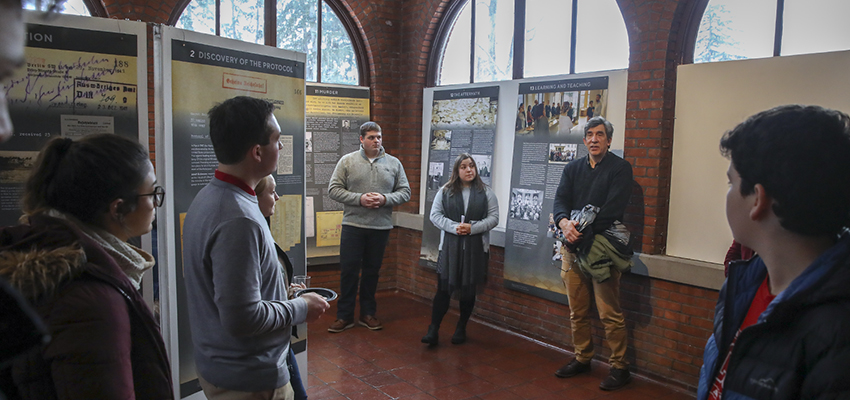
HWS News
19 March 2019 The Wannsee Conference and Bearing Witness to Hope
In 1942, German government officials and SS leaders gathered in the Berlin suburb of Wannsee and formalized implementation of and support for the Final Solution, the plan to commit genocide against Jews. This meeting, and its aftermath, is the subject of the traveling exhibit “The Wannsee Conference and the Persecution and Murder of the European Jews,” which was on display on the HWS campus from Feb. 7 through March 1.
At the opening reception in the Solarium Gallery at Houghton House in mid-February, HWS students, faculty and staff recalled visiting the Wannsee House in person though The March: Bearing Witness to Hope. Every two years, HWS and Nazareth College collaborate to lead a 10-day tour though Poland and Germany to study the Holocaust under the collective guidance of Holocaust scholars, survivors, and Israeli and Polish guides.
Speakers at the reception reflected on The March and the themes of the exhibit, notably how hundreds of thousands of ordinary bureaucrats and administrators were culpable in the Holocaust as they went about day-to-day tasks.
For those officials at Wannsee, “it was an everyday business meeting in the beautiful countryside,” Joshua Hylkema ’21 said during the HWS event, “but you know in the big and larger picture, it had a huge impact on millions and millions of people.”
Julianne Miller, director of the Abbe Center for Jewish Life and HWS Hillel Adviser, noted that in confronting the events of the Wannsee Conference, “you are forced to really grapple with those questions of how could people do this and how could it seem so normal and every day that you could have a meeting about it in this setting. When you are in the camps you think about that question, but mostly you are immersed, or at least I was immersed in the experience of the people who suffered there…. [W]hen you are at Wannsee you are really reminded that you are removed from that and you’re forced to engage with this question of how could people do this…how could it be so widespread within not only the Nazi party, but the German government and German society. You’re really forced to engage with how many people were part of this process in order to make this happen.”
Sarah Walters ’19 said she is grateful for the exhibit’s proximity to the HWS community, which allows the Colleges and Geneva communities at large to bear witness themselves. During The March, “follow[ing] the steps of the Holocaust to see how victims were treated and how they perished and how some people survived…we got to see these things up close and personal [which] is really important in preserving memory and protecting future victims — and preserving our ability to prevent these tragedies in the future,” she said.
Professor of Religious Studies Michael Dobkowski and Associate Professor of Religious Studies Richard Salter ’86, P’15, who have each been faculty leaders with The March, also addressed the audience at the exhibit opening.
Earlier in the semester Matthias Hass, an expert on the Wannsee Conference and the exhibit’s curator, visited campus as part of the HWS Human Rights and Genocide Symposium to discuss the conference, the perpetrators of the Holocaust and its survivors.
Hass works in the academic department of the House of the Wannsee Conference Memorial Site and Education Center in Berlin. His expertise includes the fields of politics of memory, European integration and international exchange programs. Over the years, he has worked for a number of organizations such as UNESCO, the Federal Association for Civic Education and the Körber Foundation. He was the director of the U.S. program of Action Reconciliation Service for Peace in Philadelphia from 2005 to 2009.
Established in 1999 at HWS, the Human Rights and Genocide Symposium seeks to improve understanding of all life-annihilation processes inherent in our modern world and to help participants learn more about the circumstances under which life-destruction processes tend to focus on specific groups in events known as genocide. The event is generously funded by Dr. Edward Franks ’72.
